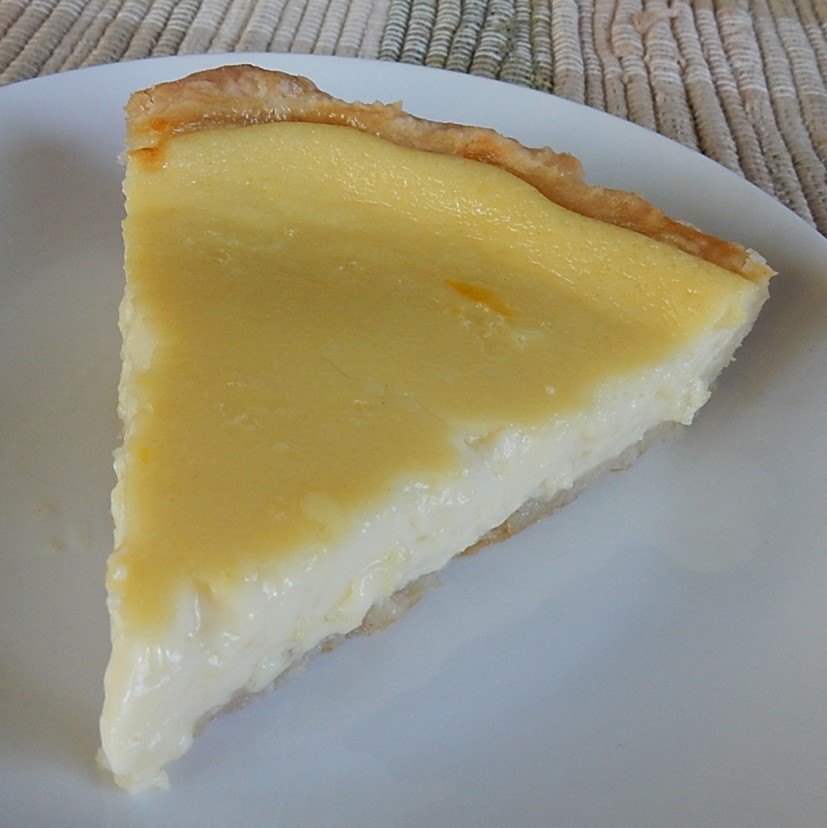Sometimes the basics are best. For example, old-fashioned Custard Pie is a delightful, delicate pie that makes a perfect treat on hot summer days. The hundred-year-old recipe I used was easy to make, and only contained five ingredients: eggs, sugar, salt, milk, and vanilla extract.
Here’s the original recipe:

When I made the recipe, I used 1/2 teaspoon of salt. The one teaspoon of salt called for in the original recipe seemed like a lot. I couldn’t figure out why it was necessary to scald the milk prior to mixing with the other ingredients, so I skipped that step – and it worked fine. It did take longer for the filling to set than the recipe indicated. Maybe the time would have been reduced if I had scalded the milk first.
And, here’s the recipe updated for modern cooks:
Custard Pie
3 eggs
3/4 cup sugar
1/2 teaspoon salt
2 cups milk
1 teaspoon vanilla extract
1 9-inch pie shell
Preheat oven to 425° F. Put eggs, sugar, salt, milk, and vanilla extract in a mixing bowl. Beat until smooth. Pour into pie shell. Bake for 10 minutes. Reduce heat to 325° F.. Bake additional 50 minutes or until knife inserted into center of pie comes out clean.

That looks really good. I love custard.
It’s tasty.
They’re not for me, but I remember Mum and Nan making these 🙂
It’s nice to hear that this post brought back memories of these pies – even if they aren’t for you. 🙂
Yum! And this sounds easy enough for me to make.
Yes, it is a easy, simple recipe to make.
This looks wonderful. I really like custard, although it surprised me to see there’s no nutmeg included.
I also was surprised that the old recipe didn’t call for nutmeg. I think that most modern custard pies contain it.
I had to laugh when reading the ingredients to the custard and saw that 1 tsp of salt–said to myself, Sheryl will say that seemed like a lot, and she will reduce it. It does seem like a lot to me, too! My grandmother used to make custard pie a lot. I think scalding the milk was because a lot of milk was fresh from the cow then–not pasteurized like now. I can recall my grandmother scalding milk for almost everything she baked. In South Africa they call custard a Milk Tart and it was my favorite–the store across the street from our flat had them and I bought one every few days!
Your comment made me smile. I guess that I’m becoming predictable. It makes sense that people may have scalded milk more back in the days when raw milk was commonly used.
I’ll take a piece of that with a little coconut sprinkled on top!😋😋😄
mmm. . . coconut would be really nice on this pie.
The explanation above seems reasonable about scalding milk. I wonder if it is still necessary since I still find recipes that ask for it and I duly comply.
I did do a little looking, and while killing bacteria was the original reason, apparently, it also helps with the heating process in making custards, helps in bread making to activate the yeast, and keeps something (gluten?–I forgot) from making the bread tough. Bottom line in most things I found was if a recipe called for scalding the milk, do it; it is worth the effort. Since I learned to cook from my grandmothers and mother, I did it because they said so. 🙂
I am glad for this information.
Thanks for researching this. I’ll take the time to scald the milk the next time I make a recipe calling for it. Our mothers and grandmothers were very knowledgeable when it came to knowing sound cooking processes and procedures.
As a result of reader’s comments, I’ve learned why milk should be scalded, and definitely will scald milk the next time I make a recipe that calls for it. I am so fortunate to have wonderful readers who share their information and knowledge.
Me too.
That sounds similar to a Southern Chess Pie. Good eatin’.
I do love a good chess pie!
Me, too!
I’m not very familiar with Chess Pie – but your comment and the others make me want to try it.
I think they are similar – though Chess Pie contains cornmeal and Custard doesn’t.
Thanks for pointing out the difference between the two pies. I couldn’t remember.
I put a link to your Home page from my blog — https://amehrling.com/2020/07/11/england-40-years-ago-july-6-1980/ I loved the posting of your grandmother’s diary and borrowed the idea for my project. Thank you for the idea.
Thanks for sharing the link. It’s wonderful to read your old letters from when you were in England. It’s nice to hear that my posting of my grandmother’s diary helped you come up with this idea.
You are most welcome. I thought your idea was brilliant.
A sugar cream pie/ custard pie is one of my favorites! It is so tasty especially after chilling it over night. Now I’m hankering for one!
It is a yummy pie!
I’m trying this one soon! Looks so creamy and delicious!
I think that you’ll like this recipe. The pie is delicious.
That looks like a lovely recipe, I must try it for my granddaughter.xxx
I think that your granddaughter would like this pie.
One of my all-time favorite old fashioned pies is custard pie. Interesting how there’s no nutmeg in this recipe. I thought that was *always* part of custard. 🤔
I was also surprised that this recipe didn’t call for nutmeg.
Wow…i think this is so good 🌟
It’s tasty.